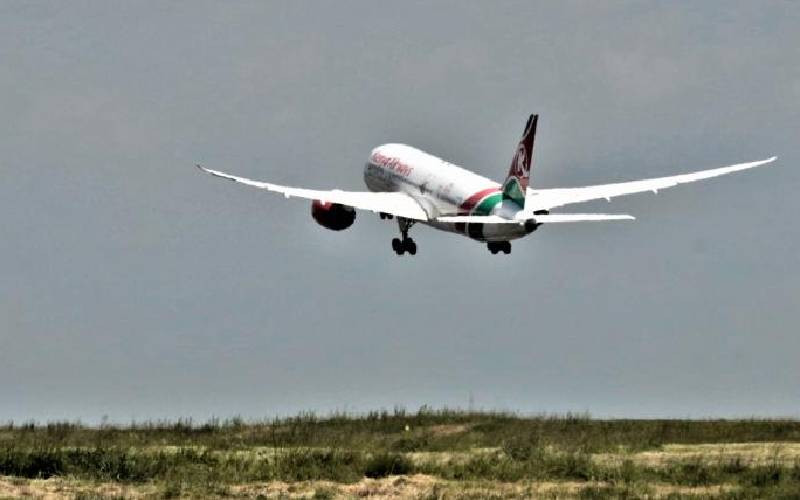 |
|
Looking out towards the ocean from the Hemmingway’s Watamu Resort. [Photo: Allan Olingo/Standard]
|
MOMBASA, KENYA, Nov. 22 -If you want to enjoy the Watamu coastal charm, forget about swimming in the ocean and concentrate on the good things, like lying in a hammock with a book, or exploring historical sites, writes ALLAN OLINGO
Leaving Nairobi on a Lamu-bound flight, we set off on a light note with a prank from the airport. Charity, one of our colleagues had forgotten her phone at the airport-waiting lounge and I decided to hide it.
Mid-flight, she realised that she did not have it and pleaded with the airhostess to call Nairobi.
A stopover at Lamu was refreshing. As the plane lost height towards the runway, a beautiful outcrop of the blue turquoise water with green shrubs opens up.
Everyone in the plane wanted to have a fair share of the sight of rolling dunes and endless beaches, where tiny villages nestle among coconut; plantations and dhows ply the waters.
I am not a fan of flying and I wear out the arms of my chair from gripping them too tight, especially at takeoff and landing, and this was no exception.
We left Lamu and landed at the Malindi Airport 25 minutes later then left for Watamu, primarily a beach resort destination.
We checked in to the Hemmingway’s Watamu Resort and immediately noticed the fish carvings that dot the reception. Biko, my colleague murmured something to the effect that Luos would never hang a fish as a souvenir as we drank dawa, a local brew.
“That is like having a Luhya hang a whole chicken on his wall,” he joked as the porters led us to the room.
Hemmingway’s borrows its name from Ernest Hemingway, the explorer. The famous writer, Ernest Hemingway, stayed in Malindi in 1934 and it is said that he went fishing on the Watamu coast.
Hemmingway’s sits on a more accessible beach. It stands out as a large hotel that has retained its character, friendliness and personal service.
It has also resisted the bug of over-ambitious expansion, which has afflicted so many coastal hotels, resulting in properties of several hundred boxy rooms and no charm.
Watamu is getting increasingly popular and ideal, since it is less busy than Mombasa and there is still plenty of crisp white sand along which to stretch your legs. It was interesting to enjoy the evening sundowners as the fishermen came back with their catch.
Within the Watamu beach front, you will find accommodation options that vary in quality of experience. This is one of those areas that are particularly nice for families or people that want a low-hassle beach stay in a comfortable hotel.
Stay informed. Subscribe to our newsletter
Must do
The next morning, we had three must do’s for the day. One of them was a visit to the nearby Arabuko Sokoke Forest where there are a number of endemic species of birds and mammals, including the peculiar golden-rumped elephant shrew and Sokoke cat.
Unfortunately, this fell through because some member in our team had already been dragged in by the allure of going fishing.
Next stop, Gedi Ruins. Located about 20 minutes from Watamu, these 12th Century ruins of the ancient Arab city of Gedi are said to have once been a centre civilisation of Swahili people ruled by a wealthy Sultan and was mysteriously abandoned in the last part of the 17th Century.
Walking through the ruins with a curator, one gets a feel of this city. The outer walls of the city encompass the Sultan’s palace, a great mosque, pillar tombs, wells, baths, courts and everything necessary for a cultured Arab society of the time.
The National Museums have excavated and restored the place and there are knowledgeable guides to give conducted tours.
As we strolled among the ruins, cheeky monkeys played above our heads, scouting the female guest as they jumped from tree to tree, among the baobab, tamarind and other indigenous trees.
The incessant chirping of the birds in the background adds a different feel to the ruins. Quite harmless by day but I am not sure I would walk the route in the dark, not that I am afraid of the dark, but funny stories abound about the coast and ruins.
We drove back for lunch before heading to the bar for an afternoon drink.
Quite frankly, if you want to enjoy the coastal charm, forget about wasting your energy swimming in the ocean. Instead, concentrate on the good things in life.
Like enjoying a nice read on a hammock sipping whisky, as you stare into the endless ocean, or read a book. I am not sure whether reading a book on whisky might be a good idea though, just doesn’t seem right.
We chose to drink from the poolside bar as we watched other tourists swim their energy away.
The next morning, we headed to the nearby Bio-Ken Snake Farm on the Mombasa-Malindi highway.
Snakes are not my favourite animals. The scaly skin, the calculating eyes, darting tongues, definitely not my cup of tea.
I was not alone as most of the men in the group took a backseat as the women posed, enquired and even milked venom from these animals, luckily no one made a quip of the situation.
This farm is a research centre, which deals with reptiles, especially snakes and snakebites. It houses the largest collection of snakes in East Africa and is open to the public.
From Royjan, one of the centre’s directors, I learnt that there are about 127 different snake species in Kenya, of which only 18 have caused human fatalities and only another six could kill.
Another ten could cause you a lot of pain and the remaining 93 or so, are neither non-venomous nor dangerous. Interesting huh? And the way we kill whatever snake crosses our path without thinking twice.
There, of course, might be that tiny problem of pausing long enough to find out if what lies across your path is a poisonous snake, or some harmless chap on a stroll.
As we left for Nairobi, I had learnt one thing about group travel; almost everyone deliberately delays.
 The Standard Group Plc is a
multi-media organization with investments in media platforms spanning newspaper
print operations, television, radio broadcasting, digital and online services. The
Standard Group is recognized as a leading multi-media house in Kenya with a key
influence in matters of national and international interest.
The Standard Group Plc is a
multi-media organization with investments in media platforms spanning newspaper
print operations, television, radio broadcasting, digital and online services. The
Standard Group is recognized as a leading multi-media house in Kenya with a key
influence in matters of national and international interest.
 The Standard Group Plc is a
multi-media organization with investments in media platforms spanning newspaper
print operations, television, radio broadcasting, digital and online services. The
Standard Group is recognized as a leading multi-media house in Kenya with a key
influence in matters of national and international interest.
The Standard Group Plc is a
multi-media organization with investments in media platforms spanning newspaper
print operations, television, radio broadcasting, digital and online services. The
Standard Group is recognized as a leading multi-media house in Kenya with a key
influence in matters of national and international interest.










